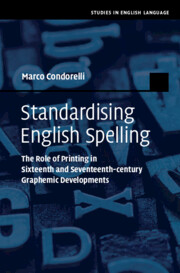 Standardising English Spelling
Standardising English Spelling Book contents
- Standardising English Spelling
- Studies in English Language
- Standardising English Spelling
- Copyright page
- Contents
- Figures
- Tables
- Acknowledgements
- Abbreviations
- Chapter 1 Introduction
- Part I Context
- Chapter 2 Theoretical Framework
- Chapter 3 Pragmatic Framework
- Part II Empirical Method
- Part III Case Studies
- Bibliography
- Index
Chapter 2 - Theoretical Framework
from Part I - Context
Published online by Cambridge University Press: 31 March 2022
- Standardising English Spelling
- Studies in English Language
- Standardising English Spelling
- Copyright page
- Contents
- Figures
- Tables
- Acknowledgements
- Abbreviations
- Chapter 1 Introduction
- Part I Context
- Chapter 2 Theoretical Framework
- Chapter 3 Pragmatic Framework
- Part II Empirical Method
- Part III Case Studies
- Bibliography
- Index
Summary
Chapter 2 provides an overview of some fundamental theoretical questions – the when, the what, the who and the how – about spelling standardisation in Early Modern English. Spelling represents one of the most complex facets of linguistic standardisation and, for this reason, its essence escapes most of the theoretical labels that have been proposed so far for standardisation more broadly. Because of the complexities inherent to Early Modern English spelling, I suggest, we should intend the spelling system of Early Modern English as something in the process of standardising. The chapter also proposes the idea that, despite the complexities involving developments towards standardisation, Early Modern English spelling was not random and haphazard. In the closing section, a case is made for exploring large-scale patterns of development in Early Modern English spelling, and their relationship between theoreticians, schoolmasters, authors, readers and printers.
Keywords
- Type
- Chapter
- Information
- Standardising English SpellingThe Role of Printing in Sixteenth and Seventeenth-century Graphemic Developments, pp. 21 - 39Publisher: Cambridge University PressPrint publication year: 2022
